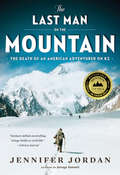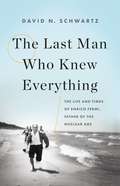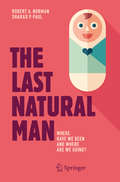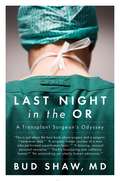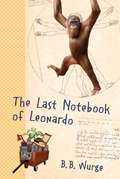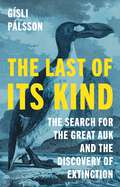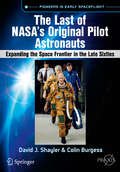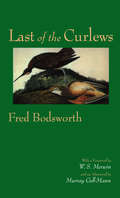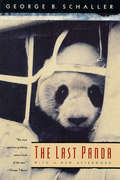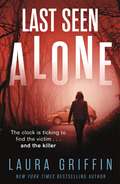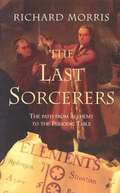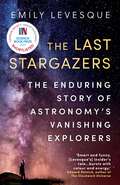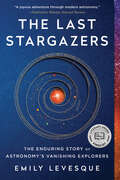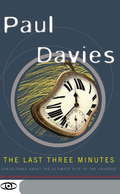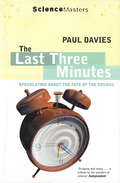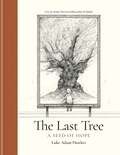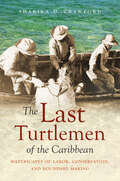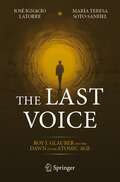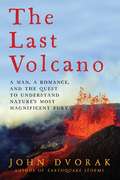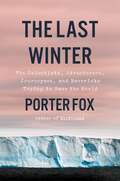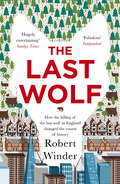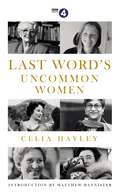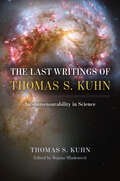- Table View
- List View
The Last Man on the Mountain: The Death of an American Adventurer on K2
by Jennifer Jordan"A fascinating tale. . . . Readers who are into high-altitude adventure stories won't be disappointed."--Associated Press In 1939 the Savage Mountain claimed its first victim. Born into vast wealth yet uneasy with a life of leisure, Dudley Wolfe, of Boston and Rockport, Maine, set out to become the first man to climb K2, the world's second-highest mountain and, in the opinion of mountaineers, an even more formidable challenge than Mt. Everest. Although close to middle age and inexperienced at high altitude, Wolfe, with the team leader, made it higher than any other members of the expedition, but he couldn't get back down. Suffering from altitude sickness and severe dehydration, he was abandoned at nearly 25,000 feet; it would be another sixty-three years before the author discovered his remains.
The Last Man Who Knew Everything: The Life and Times of Enrico Fermi, Father of the Nuclear Age
by David N. SchwartzThe definitive biography of the brilliant, charismatic, and very human physicist and innovator Enrico FermiIn 1942, a team at the University of Chicago achieved what no one had before: a nuclear chain reaction. At the forefront of this breakthrough stood Enrico Fermi. Straddling the ages of classical physics and quantum mechanics, equally at ease with theory and experiment, Fermi truly was the last man who knew everything--at least about physics. But he was also a complex figure who was a part of both the Italian Fascist Party and the Manhattan Project, and a less-than-ideal father and husband who nevertheless remained one of history's greatest mentors. Based on new archival material and exclusive interviews, The Last Man Who Knew Everything lays bare the enigmatic life of a colossus of twentieth century physics.
The Last Natural Man
by Robert A. Norman Sharad P. PaulThis book explores cultural evolution and the meaning of the word 'natural'. We are at the crossroads of a major transformation. Why is our current time so important in the history of man? We are at a point where we may be the last generation that is not partially or fully bionic. The last natural man: natural in what way? What is "natural"? Is it a catch phrase like "integrative" or "holistic" that transmits a certain magical warm glow? If the word "natural" was a plant, it would be beautiful, green, luxuriant, and edible. Does it mean we are the last to not replace or modify our parts? What about laser surgery? Knee or hip replacement? Botox and fillers? Chemical therapy? Or a directional chip in the brain?Do we really mean the very last natural man? Cultural evolution has been the major driving force over the last several thousand years and enormous in its influence compared to almost invisible changes in our physical adaptations. If cultural and religious evolution was the driver for human history, are we now entering the phase of physical transformation - where humanity refuses to accept mortality and seeks to make changes to defeat nature. In this book the authors are describing a paradigm shift of all of humanity--just as hunter-gatherers had their stellar features, the future man will have many attractive qualities, even if many artificial. We are often balancing on the precipice between science and science fiction, now ready to tip the scales and slide comfortably into the future of great discoveries and wonderful changes. But are these changes all for the good? What will being human mean? "A lively, superbly informed, compassionate conversation between two accomplished physician-writers about the human past and the human future, carefully grounded in the sciences of medicine and evolution. If you care about who we are and what may save us from ourselves, read this enormously informative and entertaining book. " Melvin Konner, MD, PhD, author of The Tangled Wing: Biological Constraints on the Human Spirit and Women After All: Sex, Evolution, and the End of Male Supremacy
Last Night in the OR
by Bud ShawFor readers of Henry Marsh's Do No Harm, Paul A. Ruggieri's Confessions of a Surgeon, and Atul Gawande's Better -- a pioneering surgeon shares memories from a life in one of surgery's most demanding fields The 1980s marked a revolution in the field of organ transplants, and Bud Shaw, M.D., who studied under Tom Starzl in Pittsburgh, was on the front lines. Now retired from active practice, Dr. Shaw relays gripping moments of anguish and elation, frustration and reward, despair and hope in his struggle to save patients. He reveals harshly intimate moments of his medical career: telling a patient's husband that his wife has died during surgery; struggling to complete a twenty-hour operation as mental and physical exhaustion inch closer and closer; and flying to retrieve a donor organ while the patient waits in the operating room. Within these more emotionally charged vignettes are quieter ones, too, like growing up in rural Ohio, and being awakened late at night by footsteps in the hall as his father, also a surgeon, slipped out of the house to attend to a patient in the ER. In the tradition of Mary Roach, Jerome Groopman, Eric Topol, and Atul Gawande, Last Night in the OR is an exhilarating, fast-paced, and beautifully written memoir, one that will captivate readers with its courage, intimacy, and honesty.From the Trade Paperback edition.
The Last Notebook of Leonardo
by B. B. WurgePraise for Squiggle and Billy and the Birdfrogs:"The characters are exceptional, weird, true to life, funny, scary, different, and definitely perk the story . . . an exceptional job. . . . Children will truly enjoy this book."-Midwest Book Review"Billy survives by the sheer weight of its own insane internal logic. . . . For those funny-book junkies out there, Billy fulfills a need. Downright weird, and that's a-okay with me, it's worth a gander."-School Library Journal"One of the best books we have read this year . . . intelligent, well composed, with a strong narrative, likable characters, and just enough scariness and tension to make it hard to put down."-BooksForKids.com"Mystery, suspense, and conflict build a plot of nonstop adventure. Character development is superb . . . clever illustrations, delightful humor, and a marvelous story. . . . Entertaining, downright funny, and highly imaginative. A great read."-Midwest Book ReviewJem's father, a scientific genius, turns himself into a nine-foot orangutan. When their landlord suggests that they leave, they pack their belongings onto a huge wagon and set out on the ultimate adventure: to find the last resting place of Leonardo da Vinci, who, according to his last notebook, may not have died in Italy. They are joined by an old Indian woman, and the threesome's adventures lead to the most unlikely of places-and meetings. Tidbits of science, fun facts about da Vinci and his works, and B.B. Wurge's trademark wacky humor, minimalist illustrations, and lessons on the importance of family make this third novel as exciting as the last two.
The Last of Its Kind: The Search for the Great Auk and the Discovery of Extinction
by Gísli PálssonHow an iconic bird&’s final days exposed the reality of human-caused extinctionThe great auk is one of the most tragic and documented examples of extinction. A flightless bird that bred primarily on the remote islands of the North Atlantic, the last of its kind were killed in Iceland in 1844. Gísli Pálsson draws on firsthand accounts from the Icelanders who hunted the last great auks to bring to life a bygone age of Victorian scientific exploration while offering vital insights into the extinction of species.Pálsson vividly recounts how British ornithologists John Wolley and Alfred Newton set out for Iceland to collect specimens only to discover that the great auks were already gone. At the time, the Victorian world viewed extinction as an impossibility or trivialized it as a natural phenomenon. Pálsson chronicles how Wolley and Newton documented the fate of the last birds through interviews with the men who killed them, and how the naturalists&’ Icelandic journey opened their eyes to the disappearance of species as a subject of scientific concern—and as something that could be caused by humans.Blending a richly evocative narrative with rare, unpublished material as well as insights from ornithology, anthropology, and Pálsson&’s own North Atlantic travels, The Last of Its Kind reveals how the saga of the great auk opens a window onto the human causes of mass extinction.
The Last of NASA's Original Pilot Astronauts: Expanding the Space Frontier in the Late Sixties (Springer Praxis Books)
by Colin Burgess David J. ShaylerResulting from the authors' deep research into these two pre-Shuttle astronaut groups, many intriguing and untold stories behind the selection process are revealed in the book. The often extraordinary backgrounds and personal ambitions of these skilled pilots, chosen to continue NASA's exploration and knowledge of the space frontier, are also examined. In April 1966 NASA selected 19 pilot astronauts whose training was specifically targeted to the Apollo lunar landing missions and the Earth-orbiting Skylab space station. Three years later, following the sudden cancellation of the USAF's highly classified Manned Orbiting Laboratory (MOL) project, seven military astronauts were also co-opted into NASA's space program. This book represents the final chapter by the authors in the story of American astronaut selections prior to the era of the Space Shuttle. Through personal interviews and original NASA documentation, readers will also gain a true insight into a remarkable age of space travel as it unfolded in the late 1960s, and the men who flew those historic missions.
Last of the Curlews (New Canadian Library)
by Fred BodsworthIn this conservation classic, originally published fifty–five years ago, Fred Bodsworth tells the story of a solitary Eskimo curlew's perilous migration and search for a mate. The lone survivor comes to stand for the entirety of a species on the brink of extinction, and for all in nature that is endangered. This new paperback edition includes a foreword by Pulitzer Prize–winning poet W.S. Merwin and an afterword by Nobel Prize–winning physicist Murray Gell–Mann.
The Last Panda (Signo Mas Ser.)
by George B. SchallerDependent on a shrinking supply of bamboo, hunted mercilessly for its pelt, and hostage to profiteering schemes once in captivity, the panda is on the brink of extinction. Here, acclaimed naturalist George Schaller uses his great evocative powers, and the insight gained by four and a half years in the forests of the Wolong and Tangjiahe panda reserves, to document the plight of these mysterious creatures and to awaken the human compassion urgently needed to save them. "No scientist is better at letting the rest of us in on just how the natural world works; no poet sees the world with greater clarity or writes about it with more grace. . . . Anyone who genuinely cares for wildlife cannot help being grateful to Schaller—both for his efforts to understand the panda and for the candor with which he reports what has gone so badly wrong in the struggle to save it from extinction."—Geoffrey C. Ward, New York Times Book Review "Schaller's book is a unique mix of natural history and the politics of conservation, and it makes for compelling reading. . . . Having been in giant panda country myself, I found some of the descriptions of the animals and habitats breathtaking. Schaller describes the daily routines and personalities of the giant pandas he studied (as well as their fates thereafter) as though they were his blood relatives. . . . Schaller's brilliant presentation of the complexities of conservation makes his book a milestone for the conservation movement."—Devra G. Kleiman, Washington Post Book World "George Schaller's most soulful work, written in journal style with many asides about a creature who evolved only two to three million years ago (about the same time as humans). . . . Here, conservation biology confronts an evil that grinds against hope and shatters the planet's diversity. Written with hope."—Whole Earth Catalog "A nicely crafted blend of wildlife observation and political-cultural analysis. . . . The Last Panda is a sad chronicle of our failure, so far, to stem the decline of the animal that may be the most beloved on the planet."—Donald Dale Jackson, Smithsonian
Last Seen Alone: The heartpounding new thriller you won't be able to put down!
by Laura GriffinWith her signature breathless pacing and suspenseful twists and turns, 'Laura Griffin never fails to put me on the edge of my seat' (USA TODAY).If you love Karen Rose, Melinda Leigh and Lisa Gardner, you'll be gripped by Laura Griffin!'I love smart, sophisticated, fast-moving romantic thrillers and Laura Griffin writes them brilliantly' Jayne Ann Krentz'A pulse-pounding romantic thriller' Publishers Weekly.............................................................................................A missing victim. A merciless killer.Up-and-coming attorney Leigh Larson fights for victims of sexual extortion, harassment, and online abuse. She's laser-focused on her career and not afraid to go after the sleaziest targets to get payback for her clients. Austin homicide detective Brandon Reynolds is no stranger to midnight callouts, but his investigation of an abandoned car on a desolate road reveals an unusual crime scene. A pool of blood in the nearby woods suggests a brutal homicide. But where is the victim? The vehicle is registered to twenty-six-year-old Vanessa Adams, yet all Brandon finds inside is a smear of blood and a business card for Leigh Larson, attorney-at-law. Vanessa had hired Leigh just before her disappearance, but Leigh has no leads on who could have wanted her dead. Faced with bewildering evidence and shocking twists, Leigh and Brandon must work against the clock to chase down a ruthless criminal who is out for vengeance..............................................................................................Raves for Laura Griffin:'Desperate Girls is a nail-biting read from the very first page to the final, shocking twist. I could not put this book down' Melinda Leigh'Griffin pulls out all the stops in a phenomenal twist ending that will leave readers stunned' Publishers Weekly
The Last Sorcerers: The Path From Alchemy To The Periodic Table
by Richard MorrisThey started with four: earth, air, fire, and water. From these basics, they sought to understand the essential ingredients of the world. Those who could see further, those who understood that the four were just the beginning, were the last sorcerers – and the world’s first chemists. What we now call chemistry began in the fiery cauldrons of mystics and sorcerers seeking not to make a better world through science, but rather to make themselves richer through magic formulas and con games. But among these early magicians, frauds, and con artists were a few far-seeing “alchemists” who, through rigorous experimentation, transformed mysticism into science. By the 18th century the building blocks of nature, the elements of which all matter is composed, were on the verge of being discovery. Initially, it was not easy to determine whether a substance really was an element. Was water just water, plain and simple? Or could it be the sum of other (unknown and maybe unknowable) parts? And if water was made up of other substances, how could it be broken down into discreet, fundamental, and measurable components? Scientific historians generally credit the great 18th century French chemist Antoine Lavoisier with addressing these fundamental questions and ultimately modernizing the field of chemistry. Through his meticulous and precise work this chaotic new field of scientific inquiry was given order. Exacting by nature, Lavoisier painstakingly set about performing experiments that would provide lasting and verifiable proofs of various chemical theories. Unfortunately, the outspoken Lavoisier eventually lost his head in the Terror, but others would follow his lead, carefully examining, measuring, and recording their findings. As the field slowly progressed, another pioneer was to emerged almost 100 years later. Dimitri Mendeleev, an eccentric genius who cut his flowing hair and beard but once a year, sought to answer the most pressing questions that remained to chemists: Why did some elements have properties that resembled those of others? Were there certain natural groups of elements? And, if so, how many, and what elements fit into them? It was Mendeleev who finally addressed all these issues when he constructed the first Periodic Table in the late 1800s. But between and after Lavoisier and Mendeleev were a host of other colorful, brilliant scientists who made their mark on the field of chemistry. Depicting the lively careers of these scientists and their contributions while carefully deconstructing the history and the science, author Richard Morris skillfully brings it all to life. Hailed by Kirkus Reviews as a “clear and lively writer with a penchant for down-to-earth examples” Morris’s gift for explanation – and pure entertainment – is abundantly obvious. Taking a cue from the great chemists themselves, Morris has brewed up a potent combination of the alluringly obscure and the historically momentous, spiked with just the right dose of quirky and ribald detail to deliver a magical brew of history, science, and personalities.
The Last Stargazers: The Enduring Story of Astronomy's Vanishing Explorers
by Emily LevesqueTo be an astronomer is to journey to some of the most inaccessible parts of the globe, braving mountain passes, sub-zero temperatures, and hostile flora and fauna. Not to mention the stress of handling equipment worth millions. It is a life of unique delights and absurdities … and one that may be drawing to a close. Since Galileo first pointed his telescope at the heavens, astronomy has stood as a fount of human creativity and discovery, but soon it will be the robots gazing at the sky while we are left to sift through the data. In The Last Stargazers, Emily Levesque reveals the hidden world of the professional astronomer. She celebrates an era of ingenuity and curiosity, and asks us to think twice before we cast aside our sense of wonder at the universe.
The Last Stargazers: The Enduring Story of Astronomy's Vanishing Explorers
by Emily LevesqueThe story of the people who see beyond the starsHumans from the earliest civilizations were spellbound by the night sky-craning their necks each night, they used the stars to orient themselves in the large, strange world around them. Stargazing is a pursuit that continues to fascinate us: from Copernicus to Carl Sagan, astronomers throughout history have spent their lives trying to answer the biggest questions in the universe. Now, award-winning astronomer Emily Levesque shares the stories of modern-day stargazers, the people willing to adventure across high mountaintops and to some of the most remote corners of the planet, all in the name of science.From the lonely quiet of midnight stargazing to tall tales of wild bears loose in the observatory, The Last Stargazers is a love letter to astronomy and an affirmation of the crucial role that humans can and must play in the future of scientific discovery.In this sweeping work of narrative science, Levesque shows how astronomers in this scrappy and evolving field are going beyond the machines to infuse creativity and passion into the stars and inspires us all to peer skyward in pursuit of the universe's secrets.
The Last Three Minutes: Conjectures About The Ultimate Fate Of The Universe
by Paul DaviesRagnarok. Armageddon. Doomsday. Since the dawn of time, man has wondered how the world would end. In The Last Three Minutes, Paul Davies reveals the latest theories. It might end in a whimper, slowly scattering into the infinite void. Then again, it might be yanked back by its own gravity and end in a catastrophic "Big Crunch. " There are other, more frightening possibilities. We may be seconds away from doom at this very moment. Written in clear language that makes the cutting-edge science of quarks, neutrinos, wormholes, and metaverses accessible to the layman, The Last Three Minutes treats readers to a wide range of conjectures about the ultimate fate of the universe. Along the way, it takes the occasional divergent path to discuss some slightly less cataclysmic topics such as galactic colonization, what would happen if the Earth were struck by the comet Swift-Tuttle (a distinct possibility), the effects of falling in a black hole, and how to create a "baby universe. " Wonderfully morbid to the core, this is one of the most original science books to come along in years.
The Last Three Minutes (SCIENCE MASTERS)
by Paul DaviesA fascinating account of current theories on the way the universe will come to an endThe last three minutes of the universe has been the subject of much scientific and lay speculation for many years. Now, Paul Davies clearly and concisely sets out the arguments for three possible outcomes:1) the universe will go on expanding indefinitely2) it will slow down and eventually collapse into a zero space, the reverse of the Big Bang3) it will reach a steady state neither expanding nor contracting but staying the same foreverAs a religious man, Davies is equally curious about the implications for humans: is there any sense in which humanity can expect to survive for eternity?
The Last Tree: A Seed of Hope
by Luke Adam HawkerFrom the Sunday Times bestselling author of Together. Imagine a world without trees. A world that is in many ways like our world, but where magnificent canopies, tree climbing and leaves rustling in the breeze are now only distant memories.Until a young girl comes along, a girl who is brave and spirited and willing to follow where her imagination takes her. Through Olive's adventures in the world of trees we are reminded of nature's extraordinary power and beauty, and her actions ultimately sow the seeds of new life in her own world.From the mind and pen of bestselling author Luke Adam Hawker, The Last Tree is a powerful evocation of the fragility of our natural world and a magnificent celebration of its beauty.Praise for Together:"An accurate and thoughtful account of one of the most challenging years in modern history." -The Guardian"Hawker's images always seem to have just the right mixture of gravitas and sly, understated humour." -The Scotsman
The Last Turtlemen of the Caribbean: Waterscapes of Labor, Conservation, and Boundary Making (Flows, Migrations, and Exchanges)
by Sharika D. CrawfordIlluminating the entangled histories of the people and commodities that circulated across the Atlantic, Sharika D. Crawford assesses the Caribbean as a waterscape where imperial and national governments vied to control the profitability of the sea. Crawford places the green and hawksbill sea turtles and the Caymanian turtlemen who hunted them at the center of this waterscape. The story of the humble turtle and its hunter, she argues, came to play a significant role in shaping the maritime boundaries of the modern Caribbean. Crawford describes the colonial Caribbean as an Atlantic commons where all could compete to control the region's diverse peoples, lands, and waters and exploit the region's raw materials. Focusing on the nineteenth and twentieth centuries, Crawford traces and connects the expansion and decline of turtle hunting to matters of race, labor, political and economic change, and the natural environment. Like the turtles they chased, the boundary-flouting laborers exposed the limits of states' sovereignty for a time but ultimately they lost their livelihoods, having played a significant role in legislation delimiting maritime boundaries. Still, former turtlemen have found their deep knowledge valued today in efforts to protect sea turtles and recover the region's ecological sustainability.
The Last Voice: Roy J. Glauber and the Dawn of the Atomic Age
by José Ignacio Latorre María Teresa Soto-SanfielMost human beings don’t manage to achieve fame. Roy J. Glauber did so for two different reasons. Glauber was not only a Nobel-Prize winning physicist, but also one of the last surviving scientists who worked in Los Alamos in the Theoretical Division of the Manhattan Project. He was a witness to all the events and knew all the scientists associated with the creation and launch of the first atomic bombs. This book is the product of a series of long interviews held with Roy over three years: in Benasque (Spain) in 2011, and later in Singapore and Cambridge (USA). Its pages give a first-hand account of a true protagonist, one who is independent, lucid, sagacious and committed to the truth. The authors have respectfully preserved his spirit: his voice is the one that matters. The authors asked the questions and they relay his answers. Their comments are confined to the footnotes and to brief explanatory paragraphs, added simply to provide certain relevant details. The importance of the events that Glauber describes here is indisputable, as therefore is the book itself. The events narrated in its pages will remain part of world history, perhaps for centuries or even millennia. We live today in the shadow of the decisions made at that time.
The Last Volcano: A Man, a Romance, and the Quest to Understand Nature's Most Magnificent Fury
by John DvorakRanging from Yellowstone in Wyoming to Mount Pelee in the Caribbean, from Bogoslof and Pavlov in Alaska, to Sakurajima in Japan, and, finally, to the massive volcanoes of Kilauea and Mauna Loa in Hawaii—The Last Volcano reveals the incredible journey of a man on a mission to understand the awesome power of volcanic eruptions. Volcanoes have fascinated—and terrified—people for ages. They have destroyed cities and ended civilizations. John Dvorak, the acclaimed author of Earthquake Storms, looks into the early scientific study of volcanoes and the life of the man who pioneered the field, Thomas Jaggar. Educated at Harvard, Jaggar went to the Caribbean after Mount Pelee exploded in 1902, killing more than 26,000 people. Witnessing the destruction and learning about the horrible deaths these people had suffered, Jaggar vowed to dedicate himself to a study of volcanoes. What followed was fifty years of global travel to eruptions in Italy, Alaska, Central America, Japan and the Pacific. In 1912, he built a small science station at the edge of a lake of molten lava at Kilauea volcano in the Hawaiian Islands, with the goal of solving the mystery of why volcanoes erupt and how they could be predicted. Jaggar found something else at Kilauea: true love. She was Isabel Maydwell, a widowed school teacher who came to Kilauea to restart her life. For more than twenty ears, she and Jaggar ran the science station, living in a small house at the edge of a high cliff that overlooked the lava lake. Maydwell would quickly becoming one of the world’s most astute observers of volcanic activity. Mixed with tales of myths and rituals, as well as the author’s own experiences and insight into volcanic activity, The Last Volcano reveals the lure and romance of confronting nature in its most magnificent form—the edge of a volcanic eruption.
The Last Winter: The Scientists, Adventurers, Journeymen, and Mavericks Trying to Save the World
by Porter FoxOne man&’s &“curiously thrilling joyride&” of travelogue, history, and climatology, across a planet on the brink of cataclysmic transformation (Donovan Hohn).As the planet warms, winter is shrinking. In the last fifty years, the Northern Hemisphere lost a million square miles of spring snowpack and in the US alone, snow cover has been reduced by 15-30%. On average, winter has shrunk by a month in most northern latitudes.In this deeply researched, beautifully written, and adventure-filled book, journalist Porter Fox travels along the edge of the Northern Hemisphere's snow line to track the scope of this drastic change, and how it will literally change everything—from rapid sea level rise, to fresh water scarcity for two billion people, to massive greenhouse gas emissions from thawing permafrost, and a half dozen climate tipping points that could very well spell the end of our world.This original research is animated by four harrowing and illuminating journeys—each grounded by interviews with idiosyncratic, charismatic experts in their respective fields and Fox's own narrative of growing up on a remote island in Northern Maine.Timely, atmospheric, and expertly investigated, The Last Winter will showcase a shocking and unexpected casualty of climate change—that may well set off its own unstoppable warming cycle.
The Last Wolf: The Hidden Springs of Englishness
by Robert WinderIt is often assumed that the national identity must be a matter of values and ideas. But in Robert Winder's brilliantly-written account it is a land built on a lucky set of natural ingredients: the island setting that made it maritime; the rain that fed the grass that nourished the sheep that provided the wool, and the wheat fields that provided its cakes and ale. Then came the seams of iron and coal that made it an industrial giant.In Bloody Foreigners Robert Winder told the rich story of immigration to Britain. Now, in The Last Wolf, he spins an English tale. Travelling the country, he looks for its hidden springs not in royal pageantry or politics, but in landscape and history.Medieval monks with their flocks of sheep . . . cathedrals built by wool . . . the first shipment of coal to leave Newcastle . . . marital contests on a village green . . . mock-Tudor supermarkets - the story is studded with these and other English things.And it starts by looking at a very important thing England did not have: wolves.
The Last Wolf: The Hidden Springs of Englishness
by Robert WinderIt is often assumed that the national identity must be a matter of values and ideas. But in Robert Winder's brilliantly-written account it is a land built on a lucky set of natural ingredients: the island setting that made it maritime; the rain that fed the grass that nourished the sheep that provided the wool, and the wheat fields that provided its cakes and ale. Then came the seams of iron and coal that made it an industrial giant.In Bloody Foreigners Robert Winder told the rich story of immigration to Britain. Now, in The Last Wolf, he spins an English tale. Travelling the country, he looks for its hidden springs not in royal pageantry or politics, but in landscape and history.Medieval monks with their flocks of sheep . . . cathedrals built by wool . . . the first shipment of coal to leave Newcastle . . . marital contests on a village green . . . mock-Tudor supermarkets - the story is studded with these and other English things.And it starts by looking at a very important thing England did not have: wolves.
Last Word's Uncommon Women
by Celia HayleyLast Word is the popular BBC Radio 4 series broadcast weekly, featuring the lives of several famous people who have recently died. More than standard obituaries, the lives are summarised with narration and include interviews with some of those who knew them. The programme was first broadcast in 2006 and this compelling anthology commemorates the remarkable and revealing lives of 80 women who were illuminating, inspiring or moving. Their names may not always be well known, but their lives made an impact on the world, and they broke new ground in many different ways. The book includes: Lt Islam Bibi - Helmand's top female police officer, shot dead by the Taliban Naty Revuelta Clews - Fidel Castro's mistress Naomi Sims - first Black supermodel Sylvia Robinson - The 'mother of hip-hop' who was the founder/CEO of Sugar Hill records Rosalia Mera - Zara founder, the world's richest self-made woman Marie Colvin - celebrated war reporter killed in Homs Clare Hollingworth - first war correspondent to report the outbreak of the Second World War Eileen Nearne - wartime spy who was captured and tortured by the Gestapo Salome Karwah - Ebola survivor who went back to Liberia to nurse other sufferers Jo Cox - MP murdered in her own Yorkshire constituency Jill Saward - rape survivor and campaigner for victims of sexual abuse Scharlette Holdman - 'The Angel of Death Row' who fought against the death penalty in the US Jeanne Cordova - former nun who became a lesbian rights activist Francis Kelsey - pharmacologist who prevented the licence of Thalidomide in the US Margaret Rule - archaeologist who raised the Mary Rose Countess of Arran - powerboat racer, 'the fastest granny on water'
Last Word's Uncommon Women
by Celia HayleyLast Word is the popular BBC Radio 4 series broadcast weekly, featuring the lives of several famous people who have recently died. More than standard obituaries, the lives are summarised with narration and include interviews with some of those who knew them. The programme was first broadcast in 2006 and this compelling anthology commemorates the remarkable and revealing lives of 80 women who were illuminating, inspiring or moving. Their names may not always be well known, but their lives made an impact on the world, and they broke new ground in many different ways. The book includes: Lt Islam Bibi - Helmand's top female police officer, shot dead by the Taliban Naty Revuelta Clews - Fidel Castro's mistress Naomi Sims - first Black supermodel Sylvia Robinson - The 'mother of hip-hop' who was the founder/CEO of Sugar Hill records Rosalia Mera - Zara founder, the world's richest self-made woman Marie Colvin - celebrated war reporter killed in Homs Clare Hollingworth - first war correspondent to report the outbreak of the Second World War Eileen Nearne - wartime spy who was captured and tortured by the Gestapo Salome Karwah - Ebola survivor who went back to Liberia to nurse other sufferers Jo Cox - MP murdered in her own Yorkshire constituency Jill Saward - rape survivor and campaigner for victims of sexual abuse Scharlette Holdman - 'The Angel of Death Row' who fought against the death penalty in the US Jeanne Cordova - former nun who became a lesbian rights activist Francis Kelsey - pharmacologist who prevented the licence of Thalidomide in the US Margaret Rule - archaeologist who raised the Mary Rose Countess of Arran - powerboat racer, 'the fastest granny on water'
The Last Writings of Thomas S. Kuhn: Incommensurability in Science
by Thomas S. KuhnA must-read follow-up to The Structure of Scientific Revolutions, one of the most important books of the twentieth century. This book contains the text of Thomas S. Kuhn’s unfinished book, The Plurality of Worlds: An Evolutionary Theory of Scientific Development, which Kuhn himself described as a return to the central claims of The Structure of Scientific Revolutions and the problems that it raised but did not resolve. The Plurality of Worlds is preceded by two related texts that Kuhn publicly delivered but never published in English: his paper “Scientific Knowledge as Historical Product” and his Shearman Memorial Lectures, “The Presence of Past Science.” An introduction by the editor describes the origins and structure of The Plurality of Worlds and sheds light on its central philosophical problems. Kuhn’s aims in his last writings are bold. He sets out to develop an empirically grounded theory of meaning that would allow him to make sense of both the possibility of historical understanding and the inevitability of incommensurability between past and present science. In his view, incommensurability is fully compatible with a robust notion of the real world that science investigates, the rationality of scientific change, and the idea that scientific development is progressive.
